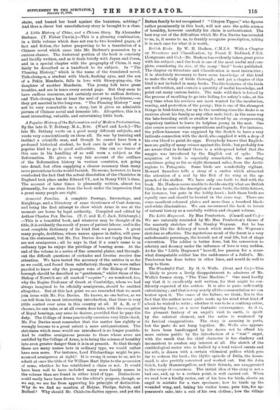Armorial Families. A complete Peerage, Baronetage, and Knightage, and a
Directory of some Gentlemen of Coat-Armour, and being the first attempt to show which Arms in use at the moment are borne by legal authority. Compiled and edited by Arthur Charles Fox Davies. (T. C. and E. C. Jack, Edinburgh.) —This is a beautiful book, and whatever may be thought of its title, it is evidently the result of years of patient labour, and is the most complete dictionary of its kind that we possess. A great many people, doubtless, whose names appear in italics, will ques- tion the statement, but Mr. Fox Davies does not imply that they are not armigerous ; all he says is, that if a man's name is in ordinary type he enjoys the privilege of bearing arms. At the end of the volume is a series of fine armorial plates, and through- out the difficult questions of cockades and liveries receive due attention. We have tested the accuracy of the entries in so far as we could, and found them satisfactory, though we were rather puzzled to know why the younger sons of the Bishop of Peter- borough should be described as " gentleman," whilst those of the Bishop of Norwich are all marked " esquire " ; we wondered, too, why the Regius Professor of Greek at Cambridge, whom we had always imagined to be officially armigerous, should bo omitted altogether. But at this last point we are reminded that we must join issue with Mr. Fox Davies. He knows, no one better, as we can tell from his most interesting introduction, that there is very little control over arms in this country at all. If A, B, or C chooses, he can take, or at all events does take, with the exception of Royal bearings, any arms he desires, provided that he pays the duty. The College of Arms practically exercises very little check. Mr. Fox Davies must remember that the matter has rightly or wrongly become to a great extent a mere antiquarianism. The strictness which some would see introduced is no longer possible. And to confine armigerous persons to those whose arms are certified by the College of Arms, is to bring the science of heraldry into even greater danger than it is in at present. So that though there are many names here in ordinary type, we would rather have seen more. For instance, Lord Fitzhardinge might be pro• nounced armigerons at sight? It is wrong it seems to us, not to admit at once the title of Sir William Hart Dyke to the possession of arms, whether he has established a claim or not. It would have been well to have included many more family names in the volume than are found in either kind of type. Distinctions could easily have been drawn for the editor's purpose, though, as we say, we are far from approving his principle of distinction. Why do we find no mention of Helyar, Phelips, Salvia, and Bulteel ? Why should Mr. Chisholm-Batten appear, and yet the
Batten family be not recognised ? " Citoyen Tippoo," who figures rather prominently in this book, will not save the noble science of heraldry, however carefully his claim is authenticated. The best way out of the difficulties which Mr. Fox Davies has revealed to us, is, it seems to us, to frankly recognise prescription, taking it in each case for what it is worth.


















































 Previous page
Previous page